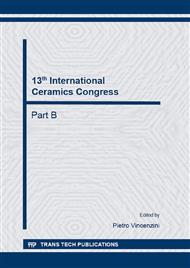p.1
p.9
p.15
p.21
p.31
p.37
p.43
p.49
SiOC Composite Structures for Intermediate Service Temperatures with Increased Friction Properties
Abstract:
Polymer Matrix Composites (PMC) are often used in lightweight applications due to their excellent mechanical properties combined with a low density. The manufacturing technologies are fully developed and raw materials are cheap. The limiting factor of these reinforced polymers is the maximum service temperature. Ceramic Matrix Composites (CMC) are suitable for service temperatures up to 1500 °C and more. These composites are composed of ceramic matrices combined with ceramic fibers based on alumina or silicon carbide. This class of composites is handicapped by the high cost of processing and raw materials and therefore only attractive for applications in astronautics and military aviation. Composite materials, bridging the gap between PMC and CMC, are manufactured by the use of polysiloxanes, carbon-and basalt fibers. Such competitive free formable Hybrid-composites are capable for service temperatures up to 800 °C in oxidative atmosphere. In order to make the material attractive also for series applications, manufacturing technologies like filament wet winding, Resin Transfer Moulding (RTM) or pressing techniques are employed. Beside the improved thermal resistivity in comparison to reinforced polymers and light metals, a major benefit of SiOC composites is investigated in the field of friction materials. The excellent properties in wear resistance and an adjustable coefficient of friction make it an interesting alternative for CFC and CMC.
Info:
Periodical:
Pages:
15-20
Citation:
Online since:
October 2014
Authors:
Price:
Сopyright:
© 2014 Trans Tech Publications Ltd. All Rights Reserved
Share:
Citation:


